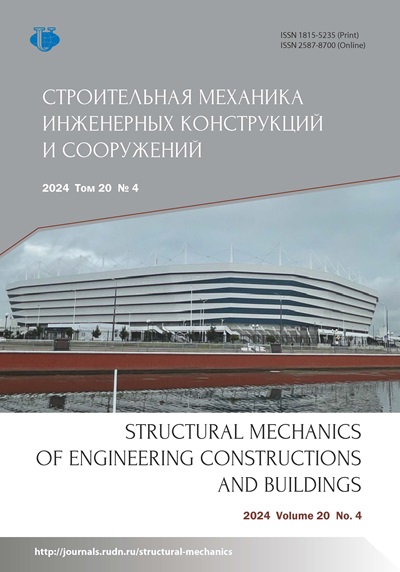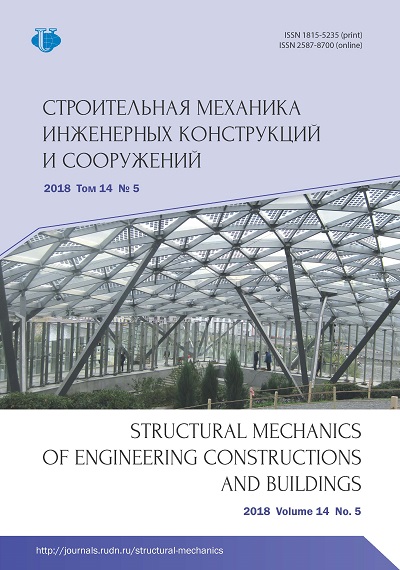Учет наполнения водохранилища при расчете напряженно-деформированного состояния бетонной плотины
- Авторы: Баклыков И.В.1
-
Учреждения:
- АО «Проектно-изыскательский и научно-исследовательский институт “Гидропроект” им. С.Я. Жука»
- Выпуск: Том 14, № 5 (2018)
- Страницы: 390-395
- Раздел: Расчет и проектирование строительных конструкций
- URL: https://journals.rudn.ru/structural-mechanics/article/view/20204
- DOI: https://doi.org/10.22363/1815-5235-2018-14-5-390-395
Цитировать
Полный текст
Аннотация
Цель. В работе рассматривается вопрос учета водохранилища при расчете напряженно-деформированного состояния бетонной плотины и ее основания. Методы. Как правило, водохранилища в глобальном масштабе представляют собой большую гравитационную массу в виде воды, которая оказывает воздействие на инженерно-геологическую обстановку в большой толще пород основания. Для исследования данного фактора проведены исследования силовой составляющей водохранилища на основании системы «водохранилище - сооружение - основание». Для расчетов был выбран гидроузел Богучанской ГЭС, который входит в Ангарский каскад и располагается в Сибири. Для выполнения расчетов деформированного состояния создана трехмерная математическая конечно-элементная модель системы «водохранилище - сооружение - основание» на основе которой определены прогнозные значения расчетной осадки бетонной плотины. Математическая модель состоит из фрагмента основания, представленного литосферой и верхней частью астеносферы. Для верификации предложенного учета водохранилища прогнозные величины осадки были сравнены с натурными геодезическими данными, при этом результаты сравнения показали высокую степень корреляции. Высокая степень корреляции позволяет предположить, что предложенный метод достаточно хорошо прогнозирует осадку основания и сооружения при наполнении водохранилища. Выводы. Результаты проведенных исследований и сопоставлений расчетных и натурных данных показали необходимость учета водохранилища при расчетных прогнозах величин осадки гидротехнических сооружений и их оснований. Данный прогноз важен при определении критериальных значений диагностических показателей для контроля безопасности сооружения.
Полный текст
Введение Водохранилища, создаваемые при сооружении гидроузла, являются источниками сильных техногенных воздействий на геологическую среду [1-6]. Создаваемые водохранилища формируют на большой территории техногенную гидрогеологическую обстановку. Создание водохранилищ приводит к неустановившимся фильтрационным процессам в больших массивах оснований плотин, проявляющихся в изменении силовых и температурных воздействий на горные породы. На плотинах проводятся многочисленные натурные исследования, в частности ведется мониторинг за осадкой сооружений как в строительный период, так и в период наполнения и эксплуатации сооружения. Многие авторы, ведущие наблюдения за осадкой, отмечают, что при наполнении водохранилища плотины приобретают дополнительную осадку [7-11]. Силовое воздействие на систему «водохранилище - сооружение - основание» со стороны водохранилища проявляется через несколько форм, среди которых можно выделить основные, проявляющиеся вследствие фильтрационных воздействий на массив основания и берегов, а также оставшийся в верхнем бьефе «неизрасходованный» на формирование фильтрации напор. Фильтрационные воздействия на породы основания проявляются в виде поверхностных и объемных сил. Цели исследования и постановка задачи Целью настоящей работы является определение реальной осадки ложа водохранилища с учетом давления веса водохранилища. В статье в качестве примера описываются исследования влияния водохранилища на напряженно-деформированное состояние плотины Богучанской ГЭС на основе пространственных конечно-элементных моделей системы «водохранилище - сооружение - основание». В исследованиях использовалась математическая конечно-элементная модель системы «водохранилище - сооружение - основание» в трехмерной постановке. Разработка математических моделей велась с учетом рекомендаций и наработок [12-16], которые позволили достичь высокой точности расчетов. В связи с тем, что, как правило, водохранилище ГЭС распространяется на многие километры, исследования были проведены для двух математических моделей: · общая модель, включающая территорию в несколько десятков километров, для определения общей осадки ложа водохранилища; · локальная модель, позволяющая проанализировать воздействие водохранилища на бетонную плотину. Результаты исследований Зона водохранилища Богучанской ГЭС затрагивает огромную территорию, представленную на рис. 1. Общая модель включает фрагмент основания (литосферы и верхней части астеносферы), подверженный нагрузке, вызванной весом воды в водохранилище (рис. 2). Рис. 1. Карта расположения Богучанского водохранилища [Figure 1. Location map of the Boguchansky reservoir] Axis of the Angara river Рис. 2. Общая модель системы «водохранилище - основание» [Figure 2. General model of the “reservoir - foundation” system] Основание представлено прочными материалами, в связи с этим в расчетах приняты линейноупругие модели материалов. Однако, как известно, чем глубже от дневной поверхности расположен грунт, тем он более прочный, соответственно, с глубиной дополнительные деформации от нагрузки уменьшаются. Для этого основание по высоте было разбито на слои с разными модулями деформации. Так как глубины расчетной области достаточно большие, физико-механические параметры для них были определены исключительно математически (на основе зависимости модуля деформации от скорости прохождения сейсмических волн), исходя из распределения скоростей продольных сейсмических волн [17]. Значения физико-механических параметров сведены в таблице. Результаты расчета деформированного состояния основания представлены на рис. 3. Как видно из рис. 3, после начала наполнения водохранилища постепенно под действием веса воды основание начинает прогибаться. Заметно, что при наполнении водохранилища высотой 73 м до отметки НПУ дополнительные вертикальные перемещения ложа водохранилища составляют 143 мм. Физико-механические параметры [Table. Physico-mechanical parameters] Таблица № материала [Item no.] E, МПа [E, MPa] ν γ, тc/м3 [γ, tf/m3] tgφ С, МПа [С, MPa] Название [Name] 1 16 000 0,20 - - - 1-й слой земной коры [1st layer of the earth's crust] 2 55 000 0,20 - - - 2-й слой земной коры [2nd layer of the earth's crust] 3 100 000 0,20 - - - 3-й слой земной коры [3rd layer of the earth's crust] 4 100 000 0,20 - - - астеносфера [asthenosphere] Vertical displacement, mm Рис. 3. Дополнительная осадка ложа водохранилища при его наполнении до отметки нормального подпорного уровня (НПУ) [Figure 3. Additional sediments of the reservoir bed when it is filled to the normal retaining level] При рассмотрении плана перемещений, а также разреза вдоль русла реки вблизи ГЭС (рис. 4.), можно увидеть, что вокруг водохранилища образуется так называемая «воронка проседания», которая распространяется на расстояние порядка 90 км. Натурные геодезические измерения, как правило, привязываются к фундаментальному реперу, и все измерения отсчитываются исходя из того, что репер неподвижен. Однако, как видно из рис. 4, фундаментальный репер, который обычно относится подальше от сооружения (порядка 2 км) и считается неподвижным, в свою очередь, попадает в ту самую «воронку проседания», тем самым приобретая дополнительное перемещение. В связи с этим при сравнении расчетной осадки и измеренной геодезией необходимо учитывать именно относительную расчетную осадку (относительно фундаментального репера). Сравнение осадки показано на рис. 5. Fundamental reference Dam of Boguchanskaya HPP Vertical displacement, mm Рис. 4. Вертикальные перемещения на разрезе вдоль русла реки [Figure 4. Vertical displacements in the section along the river bed] calculated data field observation vertical displacement, mm upstream level уровень верхнего бьефа (УВБ) upstream level Рис. 5. Сравнение расчетной осадки и натурных геодезических наблюдений [Figure 5. Comparison of calculated sediment and field geodesic observations] Выводы Расчеты показали, что наполнение водохранилища влияет на окружающую инженерно-геологическую обстановку. В частности, создание водохранилищ приводит к проседанию, пусть даже небольшому, поверхности вокруг самого водохранилища. Но что самое важное, наполнение водохранилища влияет на глобальные перемещения плотины.
Об авторах
Игорь Вячеславович Баклыков
АО «Проектно-изыскательский и научно-исследовательский институт “Гидропроект” им. С.Я. Жука»
Автор, ответственный за переписку.
Email: moscow_igor88@mail.ru
ведущий инженер
Волоколамское шоссе, 2, Москва, 125080, Российская ФедерацияСписок литературы
- Савич А.И., Газиев Э.Г. Влияние водохранилищ на поведение скальных массивов оснований высоких плотин // Гидротехническое строительство. 2005. № 11. С. 33-37.
- Тетельмин В.В., Уляшинский В.А. Техногенные воздействия и процессы в скальных основаниях плотин. М.: Энергоатомиздат, 1990. 160 с.
- Балавазе Б.К., Абашидзе В.Г. Наклоны и деформации земной коры в районе Ингурской ГЭС. Тбилиси: Мецниереба, 1985. 117 с.
- Савич А.И., Ильин М.М. Особенности влияния водохранилищ на скальные основания больших плотин // Гидротехническое строительство. 2003. № 3. С. 48-53.
- Тетельмин В.В., Баклыков И.В. Глубинные процессы массои теплопереноса в основаниях высоких плотин // Известия ВНИИГ. 2017. Т. 283. С. 46-54.
- Zoback M.D. Reservoir Geomechanics. Cambridge University Press, 2010. 461 p.
- Абакаров А.Р., Дурчева В.Н. Состояние Чиркейского гидроузла по данным многолетних комплексных натурных наблюдений // Гидротехническое строительство. 2004. № 9. С. 43-51.
- Дурчева В.Н., Пучкова С.М. Работа плотины Бурейской ГЭС при наполнении водохранилища // Гидротехническое строительство. 2006. № 1. С. 8-15.
- Марчук А.Н., Марчук Н.А. Тектонофизические аспекты напряженно-деформированного состояния больших бетонных плотин // Гидротехническое строительство. 2010. № 3. С. 31-34.
- Stateler J.N., Iarossi B. Using monitoring programmes to manage dam safety risks // Hydropower and dams. 2016. No. 4. Рp. 90-96.
- Brouillac P., Carreaud P. New approaches for improved dam monitoring // Hydropower and dams. 2015. No. 3. Рp. 70-75.
- Volynchikov A.N., Mgalobelov Y.B., Baklykov I.V. Connecting of the concrete and rock-fill dams at the Boguchanskaya HPP // Power Technology and Engineering. 2015. Vol. 48. No. 6. Рp. 431-438.
- Лисичкин С.Е., Рубин О.Д., Шакарс И.Э., Новиков С.П. Расчетная оценка напряженно-деформированного состояния левого блока здания Плявиньской ГЭС с учетом данных натурных наблюдений // Гидротехническое строительство. 1998. № 2. С. 47-53.
- Рубин О.Д., Лисичкин С.Е., Гребенщиков В.П., Цыбаков В.А., Нефедов А.В., Катанов А.Д., Пономарев Д.И. Расчетное обоснование решений по обеспечению надежности конструкций водосброса № 2 бетонной плотины Богучанской ГЭС // Известия ВНИИГ им. Б.Е. Веденеева. 2005. Т. 244. С. 227-233.
- Рубин О.Д., Лисичкин С.Е., Ляпин О.Б., Нефедов А.В. Исследования бетонных и железобетонных энергетических сооружений // Гидротехническое строительство. 1999. № 8/9. 1999. С. 22-28.
- Козинец Г.Л. Математическое пространственное моделирование гидроагрегатных блоков высоконапорных ГЭС // Гидротехническое строительство. 2014. № 11. С. 22-25.
- Глубинное строение слабосейсмичных регионов СССР. М.: Наука, 1987. 238 с.
















